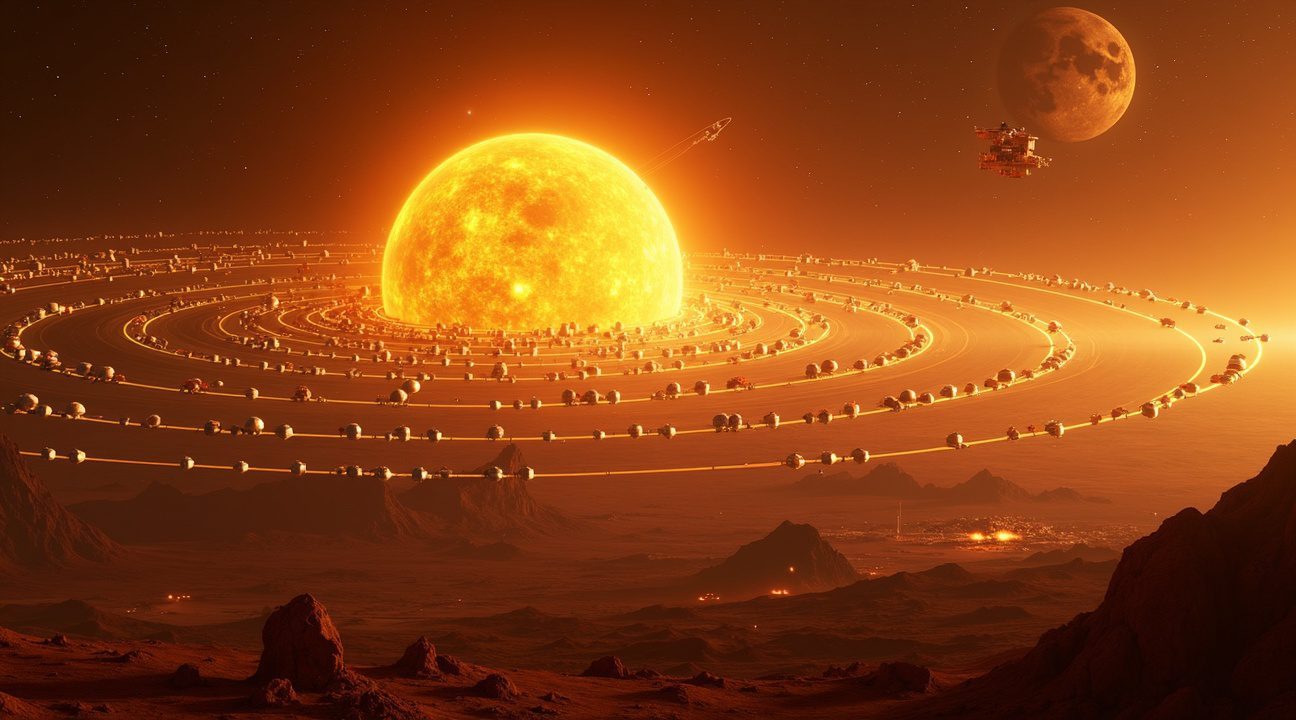Advanced civilizations facing energy constraints might construct massive stellar engineering projects called Dyson spheres to capture virtually all of their star’s energy output.
This concept has evolved from speculative science fiction into a serious area of astronomical research. Although building a solid shell around a star remains physically unfeasible due to gravitational and material constraints, more realistic models—like swarms of orbiting satellites—present a compelling theoretical alternative for harvesting stellar energy.
Key Takeaways
- Dyson swarms offer a realistic alternative to solid sphere concepts, using millions of independent satellites in stable orbits rather than attempting impossible rigid structures around stars.
- Material requirements are staggering – even a basic swarm would require dismantling entire planets like Mercury and multiple asteroids to secure enough raw materials for construction.
- Current technology falls far short of what’s needed, demanding breakthroughs in self-replicating robots, autonomous space manufacturing, and AI coordination systems to manage billions of components.
- Energy benefits would be transformative for civilization, offering virtually unlimited power for space colonization, advanced computing such as Matrioshka brains, and interstellar exploration.
- Scientific detection efforts are active as astronomers search for infrared signatures and unusual stellar dimming patterns that may hint at alien megastructures around distant stars.
The Dyson Sphere Concept
Originally proposed by Freeman Dyson in 1960, the Dyson sphere was envisioned as a natural evolutionary step for civilizations with ever-growing energy demands. Dyson suggested that advanced civilizations could build swarms of solar collectors orbiting a star, which would absorb its radiation and re-emit energy in the infrared spectrum. While his original concept did not specify solid spheres, many fictional treatments have interpreted it that way. Today, the focus has shifted toward distributed solutions like Dyson swarms.
Engineering and Material Challenges
The engineering challenge of constructing a Dyson swarm is monumental. A civilization would need to dismantle celestial bodies like Mercury to procure essential resources. Self-replicating robots would mine asteroid belts and other planetary bodies, constructing millions of satellites with autonomous manufacturing systems.
Technological Gaps
While current space technologies such as solar panels and ion drives demonstrate foundational capabilities, they are far from adequate to support a project of this magnitude. A Dyson swarm would necessitate coordinating billions of independent units operating in synchronized orbits, maintaining constant communication with a centralized control system to optimize energy absorption and redistribution.
Potential Benefits
The energy payoff of building a Dyson swarm would be extraordinary. It could harness nearly the full energy output of a star, fueling supercomputational platforms and space colonization at an unprecedented scale. One hypothetical application is the Matrioshka brain, a megastructure designed for vast computational tasks powered entirely by solar energy.
Searching for Alien Megastructures
Astronomers continue their search for Dyson spheres by analyzing infrared signatures and irregular stellar dimming phenomena. Notably, Tabby’s Star exhibited strange light fluctuations that sparked theories of alien structures, although natural causes later emerged as the more likely explanation. Nonetheless, the search presses on with enhanced tools and methodologies.
Advanced Detection Techniques
Modern observatories like the James Webb Space Telescope offer exceptional infrared sensitivity, helping to detect anomalous heat patterns that may imply artificial constructs. Machine learning algorithms further aid in sifting through vast datasets to identify unusual luminosity behaviors that traditional methods might miss.
Alternative Designs and Future Prospects
While a full Dyson sphere may remain a distant goal, partial solutions such as orbital ring systems may provide significant energy capture with far fewer materials. Alderson disks—monumental structures encircling a star’s equatorial plane—represent another possible, though still speculative, configuration.
The Long Road Ahead
Humanity’s current propulsion technologies are not yet capable of supporting mega-scale space construction. Future innovations such as fusion propulsion or antimatter engines could be key to enabling resource transport and assembly. Equally important are advances in AI and robotics, which bring the possibility of autonomous construction closer each year.
Alternative Stellar Engineering Methods
- Shkadov thrusters: Use mirror arrays to asymmetrically reflect sunlight, enabling slow propulsion of entire star systems.
- Stellar lifting: Techniques to siphon material from stars, potentially usable in large-scale manufacturing.
Conclusion
The concept of Dyson spheres remains a symbol of a civilization achieving mastery over stellar energy. Whether observed around alien stars or one day built by humanity itself, these hypothetical structures highlight not just technological ambition, but the profound transformation of a civilization’s relationship with energy. Continued research, exploration, and technological innovation may one day make these cosmic engineering marvels a reality.
The Physics Behind Harnessing an Entire Star’s Power Output
I find the concept of Dyson spheres fascinating because they represent humanity’s ultimate attempt to solve energy scarcity through stellar engineering. Freeman Dyson introduced this revolutionary idea in 1960, drawing inspiration from Olaf Stapledon’s 1937 novel Star Maker, though the underlying physics presents both incredible opportunities and formidable challenges.
The fundamental appeal of advanced civilizations constructing these megastructures lies in the sheer scale of energy available from stars. Our Sun, for instance, produces approximately 3.8 × 10²⁶ watts of power continuously—that’s roughly 2 billion times more energy than Earth receives. Capturing even a fraction of this output would provide virtually unlimited energy for any technological society that has outgrown planetary resources.
However, I must emphasize that the popular depiction of Dyson spheres as solid shells surrounding stars is physically impossible. Such structures would face catastrophic gravitational instabilities because any point on the shell would experience equal gravitational pull from all directions, creating zero net force to maintain structural integrity. The shell would inevitably collapse under its own weight and the star’s gravitational influence.
Practical Engineering Approaches
The realistic implementation of stellar energy harvesting requires more sophisticated approaches than simple solid shells. Engineers and physicists have proposed several viable alternatives that address the fundamental physics constraints:
- Dyson swarms consisting of millions of independent satellites orbiting the star at various distances and angles
- Ring-shaped structures positioned at stable orbital points around the star
- Statite configurations using radiation pressure to maintain position without traditional orbital mechanics
- Shkadov thrusters that harvest energy while simultaneously providing stellar propulsion capabilities
These alternatives sidestep the gravitational instability problem by utilizing orbital mechanics rather than attempting to create massive rigid structures. Each satellite or component in a Dyson swarm would maintain its own stable orbit, collecting solar energy through advanced photovoltaic arrays or other energy conversion technologies.
The material requirements for such projects stagger the imagination. Constructing even a partial Dyson swarm would require dismantling entire planets or asteroid belts to obtain sufficient raw materials. I calculate that building a structure capable of intercepting just 1% of our Sun’s output would demand more mass than exists in all the asteroids in our solar system combined.
The engineering challenges extend beyond mere construction. Maintaining orbital stability across millions of individual components, managing heat dissipation from such massive energy collection, and transmitting power across interplanetary distances would require technologies far beyond our current capabilities. These systems would need to operate reliably for centuries or millennia without direct maintenance intervention.
Artificial intelligence would likely play a crucial role in managing such complex systems. The computational requirements for coordinating millions of satellites, optimizing energy collection efficiency, and maintaining structural integrity would exceed human capabilities by orders of magnitude.
I believe that civilizations capable of constructing Dyson spheres would represent a fundamental transition point in technological development—what scientists call a Type II civilization on the Kardashev scale. Such societies would have mastered not only stellar engineering but also the social and political coordination necessary to undertake projects spanning multiple generations.
The detection of Dyson spheres around distant stars has become an active area of astronomical research. Scientists search for stellar signatures that show unusual infrared emissions or periodic dimming patterns that might indicate artificial structures intercepting starlight. While no confirmed detections exist yet, the search continues as our observational capabilities improve and space exploration technologies advance.
The physics of stellar energy harvesting ultimately represents one possible pathway for civilizations to transcend planetary limitations and achieve truly cosmic-scale influence. Whether humanity will ever develop the technological sophistication and social coordination necessary for such undertakings remains an open question, but the theoretical framework provides a compelling vision for our species’ long-term future among the stars.
https://www.youtube.com/watch?v=pNE0gDBdUU4
Why Scientists Prefer Swarms of Satellites Over Solid Shells
Most engineering studies and scientific discussions favor the Dyson Swarm model over the traditional solid sphere concept. This approach involves deploying a vast array of independent solar power satellites that orbit the star in organized formations. Engineers find this design far more practical because it eliminates the structural impossibilities of maintaining a solid shell around a star.
The Numbers Behind a Dyson Swarm
A proposed Martian-orbit swarm would require over 5.5 billion satellites to meet Earth’s 2019 energy consumption of 18.35 terawatts. Current designs could initially harness 0.74% to 2.77% of the Sun’s output, which generates an astounding 3.85×1026 watts. This massive energy potential makes the concept particularly attractive to civilizations planning ambitious projects like Mars colonization.
The scalability factor proves crucial for long-term viability. Advanced civilizations could start with smaller swarms and gradually expand their networks as energy demands grow. Each satellite operates independently, reducing the catastrophic failure risks associated with monolithic structures.
Essential Technologies for Implementation
Building such a swarm requires several breakthrough technologies that push the boundaries of current engineering capabilities:
- Electromagnetic accelerators would launch satellites from planetary surfaces into precise orbits
- Autonomous construction systems on Mars could manufacture satellites using local materials
- Advanced AI systems would coordinate the positioning and maintenance of billions of individual units
- Self-repairing mechanisms would ensure long-term operation without constant human intervention
These technological requirements align with current research directions, making the swarm concept more feasible than solid shell alternatives. Space agencies and private companies continue developing commercial space capabilities that could eventually support such massive construction projects.
Scientists also explore related megastructure concepts that build upon swarm technology. Matrioshka brains represent nested computational shells around stars, using the energy for massive processing power. Shkadov thrusters function as stellar engines, allowing civilizations to move entire star systems for propulsion purposes.
The preference for swarms reflects practical engineering wisdom. Rather than attempting impossible solid constructions, advanced civilizations would likely choose modular approaches that offer flexibility, redundancy, and gradual implementation. This makes the detection of potential alien megastructures more probable, as swarms would create detectable patterns in stellar light output.

The Staggering Engineering Challenges That Make Dyson Spheres Nearly Impossible Today
Building a Dyson sphere represents humanity’s most ambitious theoretical engineering project, one that pushes every technological boundary to its absolute limit. I can hardly comprehend the scale we’re discussing – even the most modest swarm variant would require materials equivalent to dismantling entire planets and asteroids. Current space manufacturing capabilities produce just a few hundred tons of materials annually, while a Dyson swarm would demand billions of satellites, each requiring sophisticated solar collectors, processors, and transmission equipment.
Material Sourcing and Manufacturing at Planetary Scale
The material requirements alone stagger the imagination. Scientists estimate that constructing a basic Dyson swarm around our Sun would require dismantling Mercury completely, along with several asteroids from the belt between Mars and Jupiter. I find myself wondering how humanity could develop the mining infrastructure to strip-mine entire worlds while simultaneously building the space-based foundries needed to process raw materials into precision components. Current asteroid mining remains in its infancy, with companies still struggling to prove basic economic viability for small-scale operations.
Energy transmission presents another monumental hurdle. Each satellite would need to beam collected solar energy back to Earth or other inhabited worlds with near-perfect efficiency. Microwave power transmission technology exists today, but scaling it to interplanetary distances while maintaining focused beams requires advances in materials science and engineering that don’t yet exist. The precision needed to keep millions of satellites in stable orbits around a star, while avoiding collisions and maintaining optimal energy collection angles, demands computational power and coordination systems far beyond our current capabilities.
The Promise and Peril of Self-Replicating Construction
Self-replicating robots offer the only realistic path forward for such massive construction projects. These autonomous systems could theoretically multiply the workforce exponentially, with each generation of robots building more robots while simultaneously constructing satellite components. I see this as humanity’s best hope for making Dyson spheres feasible, though the technology remains decades away from practical implementation.
The implications extend far beyond engineering challenges. Building a Dyson sphere would require unprecedented global cooperation, economic restructuring, and technological advancement on every front. Artificial intelligence would need to coordinate millions of construction robots, while commercial space infrastructure would need to expand by orders of magnitude. Perhaps most importantly, humanity would need to maintain social and political stability across the centuries required to complete such a project – a challenge that might prove even more difficult than the engineering obstacles themselves.

What Unlimited Stellar Energy Could Mean for Civilization’s Future
A Dyson sphere or swarm represents the ultimate renewable energy source, capturing virtually all radiation from a star to power civilizations on an unprecedented scale. This concept transforms how we think about energy limitations that currently constrain human expansion and technological development.
Breaking Through Current Energy Barriers
With access to stellar-scale energy, civilizations could overcome the fundamental bottlenecks that limit growth and exploration. Space habitats would no longer depend on scarce resources or inefficient power generation methods. Large-scale manufacturing in space becomes feasible when energy costs become negligible, enabling the construction of massive orbital cities and industrial complexes.
The surplus energy could power advanced propulsion systems for interstellar migration, making journeys between star systems practical rather than theoretical. Current space missions struggle with power limitations, but commercial space travel would evolve dramatically with unlimited stellar energy backing exploration efforts.
Computational and Technological Advancement
Matrioshka brains represent one of the most fascinating applications of Dyson sphere technology. These theoretical megacomputers could utilize entire star systems for processing power, enabling simulations of entire universes or solving computational problems that seem impossible today. The processing capabilities would dwarf anything conceivable with current technology.
Artificial intelligence development would accelerate exponentially with such computational resources. Machine learning algorithms could process datasets spanning galactic observations, potentially solving mysteries about dark matter, consciousness, or the fundamental nature of reality itself.
The concept originated in theoretical literature and science fiction before gaining serious attention in astrophysics circles. Researchers now consider Dyson structures as potential signatures of advanced civilizations, leading to active searches for artificial stellar dimming patterns. Some scientists believe alien civilizations might already employ such technology.
Projects like Mars colonization would become stepping stones rather than ultimate goals. With stellar energy at our disposal, entire solar systems could support thriving civilizations, each planet terraformed and populated using the abundant power available from captured stellar radiation.
The implications extend beyond simple energy production into fundamental questions about civilization’s trajectory and cosmic engineering capabilities.

How This Science Fiction Concept Became Serious Scientific Research
The journey from pure imagination to scientific inquiry begins with Olaf Stapledon’s 1937 science fiction novel Star Maker, where he first envisioned civilizations capable of surrounding their stars with artificial structures. This early fictional work planted the seeds for what would later become one of the most fascinating concepts in modern astrophysics and the search for extraterrestrial intelligence.
Freeman Dyson transformed this speculative idea into rigorous scientific theory in 1960 with his groundbreaking theoretical framework. The renowned physicist proposed that sufficiently advanced civilizations would inevitably face energy constraints and might construct massive structures around their host stars to capture virtually all available solar energy. Dyson’s mathematical approach gave weight to what many had dismissed as mere science fiction fantasy.
His framework didn’t just describe these megastructures as solid shells, but rather as swarms of solar collectors or habitats orbiting a star. This practical engineering perspective made the concept more feasible from a physics standpoint and opened new avenues for astronomical detection. The theoretical foundation Dyson established continues to influence how scientists approach the search for evidence of alien civilizations.
From Theory to Active Research
Modern scientists have embraced Dyson’s concept with sophisticated detection methods and observational campaigns. Astronomers now scan the skies looking for specific infrared signatures that might indicate partially constructed Dyson spheres or swarms. These searches focus on stars that show unusual dimming patterns or emit excess infrared radiation compared to their expected output.
Several research initiatives actively hunt for Dyson sphere candidates using both ground-based telescopes and space-based observatories. The Kepler Space Telescope data has been analyzed for signs of megastructures, while projects like Breakthrough Listen incorporate Dyson sphere detection into their broader search for extraterrestrial intelligence.
The scientific community has developed increasingly refined criteria for identifying potential megastructure signatures. Researchers look for stars that exhibit non-periodic dimming, unusual spectral characteristics, or infrared excess that can’t be explained by natural phenomena like dust clouds or planetary systems.
This research connects directly with broader questions about technological advancement and energy consumption patterns of hypothetical alien civilizations. Scientists studying these concepts often draw parallels with humanity’s own energy needs and potential future expansion into space, including ambitious projects like Mars colonization and commercial space travel.
The intersection of engineering analysis and astronomical observation has created a legitimate field of study that bridges multiple disciplines. Computer scientists contribute modeling capabilities to simulate how these structures might appear to distant observers. Materials scientists explore what technologies might make such massive constructions possible. Artificial intelligence researchers develop algorithms to identify potential signatures hidden in vast astronomical datasets.
Professional astronomers now publish peer-reviewed papers on Dyson sphere detection methods and candidate objects. University courses include these topics in astrobiology and SETI curricula. Grant funding supports research programs dedicated to megastructure searches, demonstrating how thoroughly this concept has moved from science fiction speculation into mainstream scientific investigation.
The evolution from Stapledon’s imagination through Dyson’s theoretical work to today’s active research programs illustrates how science fiction can inspire genuine scientific breakthroughs. What began as a writer’s creative vision has become a driving force behind some of the most ambitious searches for extraterrestrial intelligence ever undertaken.

Sources:
arXiv – Detectability of Artificial Objects Around Nearby Stars Through Infrared Excess
Wikipedia – Dyson sphere


